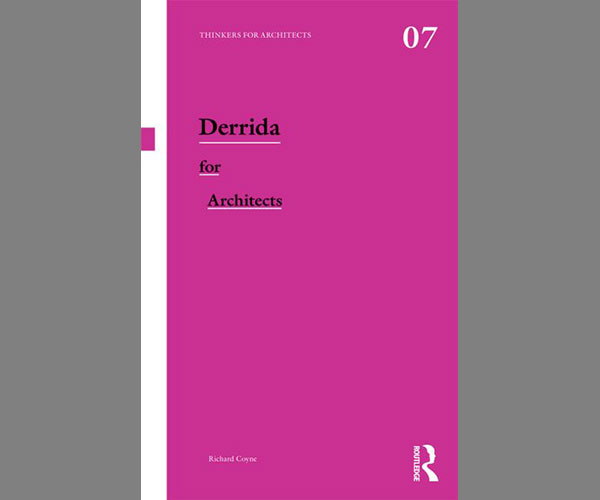
Even the most prosaic oppositions of architecture can be cast in terms that indicate something is really at stake. This is Derrida for architects. There is always something at issue, and the stakes are high. One of Derrida’s terms for the problematic conditions is the aporia, a word in Ancient Greek relating to perplexity. The key is to keep perplexity and ambiguity alive rather than to resolve it. It is to show that any putative resolution is itself fraught with further ambiguity and complexity.
– From Chapter One, “Thinking About Architecture”
Written by Richard Coyne (Routledge Press, 2014)
At a time when it seems all human endeavour has become tied to technology and obsessed with compiling mountains of meaningless data, perhaps pressing refresh on our philosophical underpinnings could provide a means to remove ourselves from this digitopia. And who better than Jacques Derrida to give us an alternative perspective, if only for a brief moment. Such is the case with architect and professor Richard Coyne’s Derrida for Architects, part of a larger series published by Routledge called ‘Thinkers for Architects,’ with other volumes on Martin Heidegger, Michel Foucault, and Walter Benjamin. In its brief 98 pages, the book examines in six chapters the way that the current practice of architecture could learn a thing or two from the late, great post-structuralist.
As any architect will recall from their architecture history classes at school, there was a symbiotic moment in the 1980’s when modern philosophy and architecture briefly coalesced, a movement which would later become known as Deconstructivism in architecture. Its philosophical origin, Deconstruction, was a term coined by Derrida himself, as he was the first to use it in his 1967 book Of Grammatology. Architects like Peter Eisenman and Bernard Tschumi found his questioning of western belief systems – those political, scientific and religious underpinnings which he called metaphysics – as a point of departure for a new architecture more critical of its meaning and context.
Coyne’s writing style is clear and his narrative straightforward. This is essential given the complexity of the material he discusses, with numerous citations to support his text throughout. In the introductory prologue, he introduces us to his subject not as an academic (he teaches architecture theory at the University of Edinburgh), or even a philosopher, but simply a writer whose works Coyne just happens to have read extensively. We then are the beneficiaries of this erudition, as to accomplish a similar feat would require not just reading Derrida’s texts – of which there are over 40 – but all the commentary that has been written about him, as well.
The first chapter, Thinking About Architecture, develops Derrida’s thinking from an architectural perspective, beginning with a quick lesson on Structuralism and introducing us to its founder, Ferdinand de Saussure. This lays the basis by which one can understand Derrida, as of all the great thinkers he deconstructed, it is Saussure who is the origin. Coyne is also considerate of the reader’s attention span on the subject, breaking each chapter into smaller parts with architectural afterthoughts. In one instance, a discussion of the historical linguists’ point of view is given an architectural analogy, questioning what a volute means beyond its reference in an Ionic capital.
The first chapter of the book lays the foundation for Derrida by introducing us to the notions of juxtaposition and opposition, concepts that architecture similarly has to deal with on a day-to-day basis. This is as well counterpointed with Derrida’s rebellion against the Structuralist notion that language is not meant to represent reality, but merely signify it. The reality that language does not reference the real world, but some other world beyond language does not bode well with him, and perhaps is a contributing factor to his sense of urgency.
In the book’s second chapter, Language and Architecture the author gives us a brief history of linguistics, from its origins in philology, to the notion of historical linguistics for which Saussure created his own elaborate system to overcome. He explains that while the historical model of linguistics looks at links between languages in a linear progression, the structuralist looks at the similar structures in all languages, regardless of their evolution. This was a notion very much in the same spirit as the High Modernist period of architecture, which sought to distill the gestalt from the program, turning simple brick and mortar into something sublime and imbued with a meaning greater than the sum of the parts.
In chapter three, Intertextuality and Metaphor, Coyne presents the theme of language through the act of writing itself by the the writer, and the role of the text, arguing that Derrida’s writing has great resonance with ideas about design, “as motivated, inspired, and propelled through a constellation of rich associations.” Chapter four, as a counterpoint to the previous chapter devoted to text, is devoted to the built work that Derrida has inspired, with a representative project from both Eisenman (Chora L Project) and Tschumi (Parc de la Villette). The book’s fifth chapter, Other Spaces, takes a more detailed look at the implications of Derrida’s thoughts on space, with the topic of Chora from the previous chapter being explored more in depth, while the final chapter, Derrida and Radical Practice, is exactly as it sounds, looking at the more political Derrida who was also an activist and demonstrator – whose On Grammatology was just as much a product as it was a commentary on the tumultuous spirit of the late 1960’s.
If nothing else, the architect reading this can see that linguistics and semiology, much like architecture, have their own unique system with their own logic and language, and Derrida reminds us that both words and buildings are not indestructible, each subject to their own scale of consequences. And the oppositions that occur in Derrida’s philosophy are the very same oppositions in architecture, those complexities, perplexities, and problems that reveal themselves in every plan and cross-section drawing, every job site and shop drawing.
Most practicing architects are accustomed to the inglorious vagaries of running a practice – the invoicing and change orders, site instructions and letters of assurance – seldom does one have the luxury to integrate such a sophisticated and complex philosophy as Derrida’s into their practice. Perhaps then, what is most important to take from him is his sense of urgency. The day-to-day problems an architect faces are also philosophical decisions – there is much at stake, whether architectural or political, economic or environmental.
In the end, Derrida for Architects asks a much more important question, i.e. where does architectural theory stand today in regards to modern professional practice? As it currently stands, it is the sad plight of architectural theory that as time progresses, it itself is diminished in our collective discourse, becoming increasingly usurped by newer and more pressing phenomena. Current issues like the economy and environment are now deemed more imperative, each accompanied by their own newer and increasingly bizarre rationalizations passing for philosophy, such as the right-wing, anti-climate claptrap that Naomi Klein writes about in her new book This Changes Everything.
This book and series will then appeal to the architect, student, and academic looking for connections between this great mind and the built environment. That his field dealt mostly in intangibles only makes one realize how powerful an idea can be, how his thinking and philosophy have and continue to influence so many, architects and all. And in a new world of memes and twitter feeds, it is the idea itself that still reigns supreme, providing the last bastion in which both the philosopher and architect can interact away from the distractions of data streams and computer screens.
***
For more information, go to Routledge.
**
Sean Ruthen is a Vancouver-based architect and writer.



